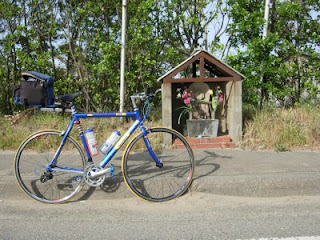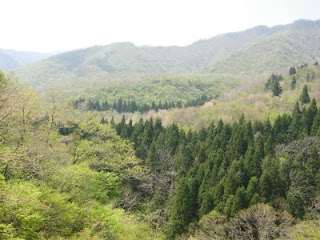


Photos 2 and 3: the sotoba, or tablets of the dead, placed beside some Japanese gravestones
Photo 4: a memorial with recently placed flowers, candle, and incense sticks
The Japanese typically cremate their dead, and the ashes of the deceased are inurned at Buddhist temples, not Shinto shrines. The total cost of plot and marker can easily run to more than 1 million yen, or 10 thousand dollars. And if one wants to ensure that the deceased receive regular memorial services for up to 100 years from contemporary and future generations of monks and acolytes, better prepare to fork over an additional million yen- death is an expensive (and lucrative) business here in Japan. Fortunately there is this consolation: only one marker per patrilineal family branch is required; all immediate members of a given family are "interred" in the same memorial. The Japanese delight in summertime chill-inducing ghost stories, so I took the following photos (with my inexpensive Japanese digital point-and-shoot) at dusk.
The Japanese typically cremate their dead, and the ashes of the deceased are inurned at Buddhist temples, not Shinto shrines. The total cost of plot and marker can easily run to more than 1 million yen, or 10 thousand dollars. And if one wants to ensure that the deceased receive regular memorial services for up to 100 years from contemporary and future generations of monks and acolytes, better prepare to fork over an additional million yen- death is an expensive (and lucrative) business here in Japan. Fortunately there is this consolation: only one marker per patrilineal family branch is required; all immediate members of a given family are "interred" in the same memorial. The Japanese delight in summertime chill-inducing ghost stories, so I took the following photos (with my inexpensive Japanese digital point-and-shoot) at dusk.


















































